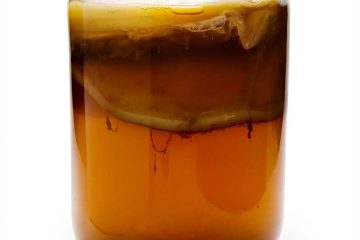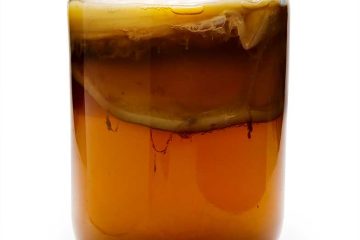Exploring the Flavor Profile of Kombucha Tea: A Refreshing Guide

Exploring the Flavor Profile of Kombucha Tea: A Refreshing Guide
Kombucha tea has been gaining popularity as a healthy and refreshing beverage in recent years. Made from fermented black or green tea, kombucha offers a unique flavor profile that is both tangy and slightly sweet, with a hint of effervescence. Its distinct taste and potential health benefits have made it a favorite among health-conscious individuals and those looking for an alternative to sugary sodas and juices.
In this guide, we will explore the flavor profile of kombucha tea and how its taste can vary based on different factors such as ingredients, fermentation process, and flavorings. Whether you’re a kombucha aficionado or a newcomer to the world of fermented teas, this article will provide valuable insights into the diverse flavors and varieties of this beloved beverage.
Understanding the Basics of Kombucha Tea
Before delving into the flavor profile of kombucha, it’s important to understand the basic components of this ancient beverage. Kombucha is made by fermenting sweetened tea with a culture of bacteria and yeast, often referred to as a SCOBY (symbiotic culture of bacteria and yeast). During the fermentation process, the SCOBY consumes the sugar in the tea and produces natural acids, carbonation, and a range of flavor compounds.
The primary ingredients in traditional kombucha include tea (usually black or green), sugar, and water. Some brewers may also add other flavorings such as fruit juices, herbs, or spices to enhance the taste of the final product. The fermentation process typically takes anywhere from one to three weeks, during which time the flavor of the kombucha develops and matures.
Tasting the Flavor Profile of Kombucha Tea
One of the most intriguing aspects of kombucha is its complex and diverse flavor profile. Each batch of kombucha can yield a unique taste experience, influenced by factors such as the type of tea used, the sugar content, the fermentation time, and any additional flavorings. Here’s a closer look at the various flavor components that contribute to the overall taste of kombucha:
1. Acidity: Kombucha is known for its tangy and slightly acidic taste, which is a result of the acetic acid produced during the fermentation process. The level of acidity can vary depending on factors such as fermentation time and the composition of the tea used. Some kombuchas may have a more pronounced sourness, while others may exhibit a milder acidity.
2. Sweetness: Despite the fermentation process consuming the majority of the sugar in the tea, kombucha typically retains a subtle sweetness that balances out its acidity. The level of sweetness can be influenced by the initial sugar content of the tea and the duration of fermentation. In some cases, brewers may also add additional sweeteners to the kombucha to achieve a desired flavor profile.
3. Aroma: The aroma of kombucha is often described as earthy, slightly fruity, and reminiscent of the tea used in the brewing process. The scent of kombucha can vary based on the type of tea and any added flavorings or infusions. Some kombuchas may exhibit floral or herbal notes, while others may have a more robust and complex aroma.
4. Complexity: A well-crafted batch of kombucha can offer a multi-layered and nuanced flavor profile that evolves with each sip. The interplay of acidity, sweetness, and subtle undertones can create a rich and satisfying drinking experience. For example, the combination of tangy acidity, delicate sweetness, and hints of fruit or spices can make for a truly enjoyable and refreshing beverage.
Varieties of Kombucha Flavors
In addition to the base flavors of kombucha derived from the tea and fermentation process, there is a wide range of flavored kombuchas available on the market. These flavored varieties often incorporate additional ingredients such as fruits, herbs, spices, and botanicals to create a diverse array of taste experiences. Some popular flavored kombucha options include:
1. Fruit-infused kombucha: Adding fruit juices or purees to kombucha during or after fermentation can impart a vibrant and refreshing fruit flavor to the beverage. Common fruit additions include berries, citrus, mango, and pineapple, which can contribute sweetness, tartness, and aromatic notes to the kombucha.
2. Herbal and botanical kombucha: Infusing kombucha with herbs, flowers, and other botanicals can create a uniquely herbal and floral flavor profile. Ingredients such as lavender, chamomile, mint, and hibiscus can complement the natural acidity of kombucha and introduce new layers of complexity to the taste.
3. Spiced kombucha: Incorporating spices such as ginger, cinnamon, cardamom, and cloves into kombucha can add warmth, depth, and a touch of spice to the beverage. Spiced kombuchas are often favored for their comforting and invigorating flavor profiles, especially during the colder months.
4. Specialty kombucha blends: Some kombucha brewers experiment with unconventional flavor combinations, using ingredients like vanilla, cacao, coffee, and even chili peppers to create bold and distinctive flavor profiles. These specialty blends offer a departure from traditional kombucha flavors and cater to adventurous palates.
Exploring the flavor profile of kombucha is not only a sensory experience but also an opportunity to discover new and intriguing taste sensations. By sampling different varieties and flavors of kombucha, enthusiasts can appreciate the diversity and creativity within the world of fermented teas.
Pairing Kombucha with Food
The versatile flavor profile of kombucha makes it a suitable companion for a wide range of foods. From light and fresh pairings to more robust and flavorful combinations, there are numerous ways to enjoy kombucha alongside various dishes. Here are some suggested food pairings to complement the distinct flavor profile of kombucha:
1. Light and citrus-infused kombuchas: These kombuchas pair well with salads, seafood, and light pasta dishes. The bright and citrusy flavors of the kombucha can accentuate the freshness of the food, creating a harmonious and refreshing dining experience.
2. Fruit-forward kombuchas: Kombuchas infused with fruit flavors are ideal for pairing with cheese platters, charcuterie, and fruit-based desserts. The natural sweetness and acidity of the kombucha complement the richness of cheeses and the sweetness of ripe fruits.
3. Herbal and floral kombuchas: These kombuchas can be enjoyed alongside dishes featuring fresh herbs, grilled vegetables, and aromatic rice or grain-based dishes. The earthy and floral notes of the kombucha can enhance the herbal and savory elements of the food.
4. Spiced and specialty kombuchas: Pairing spiced kombuchas with bold and flavorful foods such as curry, barbecue, and spicy dishes can create a dynamic contrast of flavors. The warmth and complexity of the kombucha can stand up to the intensity of heavily seasoned or spiced dishes.
By exploring different food pairings, kombucha enthusiasts can discover how the beverage’s diverse flavor profile can complement, contrast, or enhance various culinary delights. The interplay of flavors between kombucha and food offers a delightful opportunity for creative and satisfying dining experiences.
Creating Your Own Flavorful Kombucha Creations
For those who are eager to experiment with crafting their own kombucha flavors, there are endless possibilities for creating personalized and distinctive brews. Whether it’s utilizing unique fruit combinations, exploring floral infusions, or incorporating exotic spices, the art of flavoring kombucha is a creative and rewarding pursuit.
To get started with creating your own flavorful kombucha creations, consider the following tips and ideas:
1. Explore seasonal ingredients: Take advantage of seasonal fruits, herbs, and spices to infuse your kombucha with fresh and vibrant flavors. Whether it’s summer berries, fall spices, or spring herbs, seasonal ingredients can inspire new and exciting kombucha flavor combinations.
2. Blend different flavors: Experiment with combining multiple fruits, herbs, or spices to create complex and harmonious flavor profiles. Blending complementary or contrasting flavors can result in kombuchas that offer intriguing and dynamic taste experiences.
3. Incorporate non-traditional ingredients: Don’t be afraid to think outside the box and incorporate non-traditional ingredients into your kombucha brews. From exotic fruits to unconventional spices, the addition of unexpected elements can yield unexpected and delightful flavors.
4. Seek inspiration from other beverages and cuisines: Draw inspiration from your favorite cocktails, teas, sodas, or international cuisines to spark ideas for innovative kombucha flavor combinations. Borrowing flavor profiles and ingredients from other culinary traditions can lead to inventive and captivating results.
By embracing creativity and experimentation, homebrewers can unlock a world of possibilities for crafting their own flavor-packed kombucha creations. Whether it’s a personal indulgence or a shared hobby with friends and family, the process of flavoring kombucha offers endless opportunities for enjoyment and discovery.
In conclusion, the flavor profile of kombucha tea is a captivating and ever-evolving landscape of tastes, aromas, and sensations. From the crisp tanginess of traditional kombucha to the myriad of flavored varieties, there is a vast array of flavors to explore and savor. Whether enjoyed on its own or paired with a delicious meal, kombucha offers a refreshing and invigorating drinking experience that continues to captivate and inspire enthusiasts worldwide.
As more individuals embrace the benefits of kombucha, there is a growing appreciation for the diverse and exciting flavor possibilities that this beloved beverage has to offer. By embracing the versatility and creativity of kombucha, enthusiasts can continue to push the boundaries of flavor exploration, resulting in a rich tapestry of unique and compelling kombucha experiences. Whether enjoyed in its traditional form or through the lens of innovative flavor combinations, kombucha remains a delightful and vibrant addition to the world of beverages.
[elementor-template id=”430″]
[elementor-template id=”433″]




0 Comments